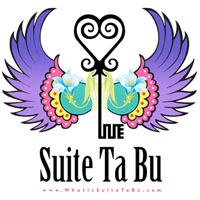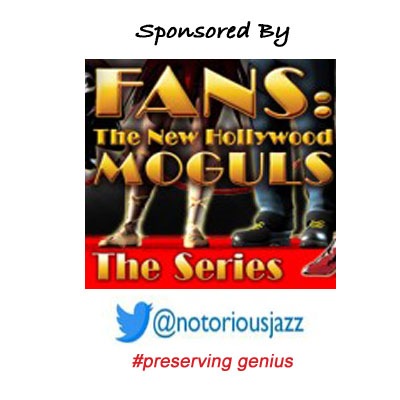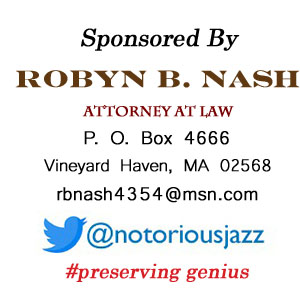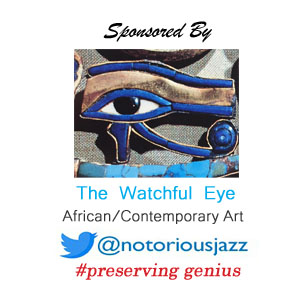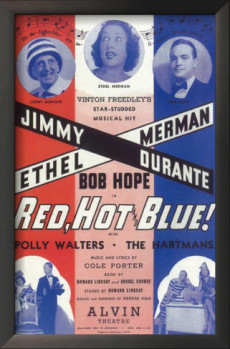
From Broadway To 52nd Street
Red, Hot And Blue! opened the Alvin Theater stage on October 29, 1936. The music and lyrics, composed by Cole Porter, rendered the tune “It’s De-Lovely” sung by Ethel Merman. Though the show only ran for one hundred and eighty-three performances, the song became an enduring jazz standard. The story taken from the book by Howard Lindsay and Russell Crouse goes as follows:
The Story: Loud and brassy manicurist Nails O’Reilly Duquesne is a newly wealthy young widow. Organizing a benefit for her favorite cause, the rehabilitation of ex-convicts, she teams with her ex-con sidekick Policy Pinkle and her “square” boyfriend, lawyer Bob Hale. Soon she embarks on a nationwide search for Bob’s old girlfriend, which is really the reason for the enterprise. However, the national lottery that Nails starts gets the attention of the Finance Committee, winding up in Washington DC in an even more complicated situation, with the Supreme Court declaring the lottery unconstitutional, because it would benefit the people.
Jazz History: The blocks of 52nd Street between Fifth and Seventh Avenue were renowned in the mid-20th century for the abundance of jazz clubs and lively street life. The street was convenient to musicians playing on Broadway and the “legitimate” nightclubs and in the CBS studio. Musicians who played for others in the early evening played for themselves on 52nd Street.
In its heyday from 1930 through the early 1950s, 52nd Street clubs hosted such jazz legends as Miles Davis, Harry Gibson, Dizzy Gillespie, Billie Hoiday, Nat Jaffe, Marian McPartland, Thelonious Monk, Charlie Parker, Louis Prima, Art Tatum, Fats Waller and numerous more. Although musicians from all schools performed there, after Minton’s Playhouse in Harlem, 52nd Street was the second most important place for the dissemination of bebop. In fact, a tune called “52nd Street Theme” by Thelonious Monk became a bebop anthem and jazz standard.
Sponsored By
www.whatissuitetabu.com
More Posts: broadway

Daily Dose Of Jazz…
Harlem was originally a wealthy white suburb of the New York City borough of Manhattan at the turn of the 20th century, but over-speculation led to a collapse of the housing boom and by 1904, fed by the Great Migration, thousands of Blacks began to reside in Harlem, taking advantage of inexpensive rents. By the 1920’s it became the major residential, cultural and business center for Black people. It was also the center of a flourishing entertainment business with black theaters and black artist performing for black audiences.
Originally a Dutch village formally organized in 1658 and named Haarlem after a Dutch town in the Netherlands and has been defined by a series of boom-or-bust cycles. Harlem was in vogue during the Roaring Twenties and the Harlem Renaissance and white socialites flocked north to hear Duke Ellington, Cab Calloway, Fats Waller, Chick Webb, Louis Armstrong and Bessie Smith. The premiere dance hall was the Savoy Ballroom with the big four clubs were The Cotton Club, Connie’s Inn, Small’s Paradise and Barron Wilkins, which was the first to open in 1915.
The Cotton Club, opened by gangster Owney Madden in 1922 moved downtown in ’36; Connie’s Inn opened in 1923 by George and Connie Immerman and Ed Smalls opened Small’s Paradise in 1925 and endured until 1986. All four catered to white audiences with lavishly staged shows featuring black performers such as James P. Johnson, Bill “ Bojangles” Robinson and Ethel Waters.
Swing and jazz were at its height and over the next several decades attracted the nightlife of both wealthy and working patrons to witness the greatest black musicians and performers in music and entertainment at a proliferation of theatres and clubs.
The most popular nightspots within the boundaries of the Hudson and East Rivers and from 100th to 155th Streets were the Alhambra Theatre, the Apollo Theatre, Bamboo Inn, Bamville Club, Band Box, Barron’s, Brittwood, Capitol Palace, Club Basha, Count Basie’s, Dickie Wells Shim Sham Club, Garden Of Joy, Golden Gate Ballroom, Harlem Club, Harlem Opera House, Heat Wave, Lafayette Theatre, Lenox Club, Leroy’s, Lido Ballroom, Lincoln Theatre, Luckey’s Rendezvous, Minton’s Playhouse, Monette’s Supper Club, Monroe’s Uptown House, Nest Club, Pod’s & Jerry’s, Renaissance Ballroom, Rendezvous Cabaret, Rhythm Club, Saratoga Club, Ubangi Club and Yeah Man.
Harlem, which has recently been given the name Manhattan North, has former President Bill Clinton to have a visible presence, has skyrocketed rental costs and townhouse sales , given much of 125th Street a makeover, attracting thousands of tourists and an influx of residents who at one time not too long ago would never have crossed Central Park North or come down into the valley from Columbia University.
More Posts: club,dance,history,instrumental,jazz,music,vocal
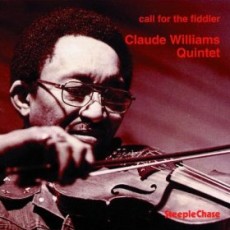
Daily Dose Of Jazz…
Claude “Fiddler” Williams, born on February 22, 1908 in Muskogee, Oklahoma, by the age of 10 had learned to play guitar, mandolin, banjo and cello and was inspired to learn the violin after hearing Joe Venuti play. He played around Oklahoma with bassist Oscar Pettiford and by 1927 had his first professional gig with Terence Holder’s territory band that soon became known as the Clouds of Joy led by Andy Kirk after Holder’s ouster.
Claude enjoyed a great deal of success due to the performing and composing talents of Mary Lou Williams. Their short-lived relationship ended due to health issues but during the thirties he worked with Alphonse Trent, George E. Lee, Chick Stevens, Nat King Cole and his brother Eddie.
In 1936 Claude became the first guitarist to record with Count Basie and throughout the 30’s and 40’s worked Chicago, Cleveland and Flint with the Four Shades of Rhythm. Throughout the 50’s he worked with Jay McShann, Eddie “Cleanhead” Vinson and Hank Jones.
Settling in Kansas City in 1953 he spent most of the next 20 years leading his own groups. By the 70’s a gig with McShann led to his first recordings in three decades and his second career was born. Over the next two decades he toured with McShann, worked as a feature soloist at jazz festivals, Parisian musical Black & Blue, a New York date with Roland Hanna and Grady Tate, played Carnegie Hall and Lincoln Center, and President Bill Clinton’s first inauguration. In 1997 Williams was the first inductee of the Oklahoma Jazz Hall Of Fame.
Claude “Fiddler” Williams, the venerable elder statesman of jazz, who outlasted virtually all his contemporaries and achieved his greatest successes at an advanced age and was the last surviving jazz musician to be recorded before 1930, passed away at the age of 96 of pneumonia in Kansas City on April 26, 2004.
More Posts: violin
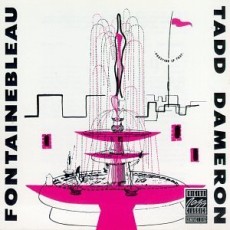
Daily Dose Of Jazz…
Cleveland, Ohio was the birthplace of Tadley Ewing Peake Dameron on February 21, 1917. Tadd as he was known in the jazz world became the definitive arranger/composer of the bop era writing such standards as “Good Bait,” “Our Delight,” “Hot House,” “Lady Bird,” and “If You Could See Me Now.” Not only did he write melody lines, he also wrote full arrangements. Though he never financially prospered, Dameron was an influential force from the mid-’40s till his death.
Dameron started out in the swing era touring with the Zack Whyte and Blanche Calloway bands, he wrote for Vido Musso in New York and most importantly, contributed arrangements for Harlan Leonard’s Kansas City Orchestra, some of which were recorded.
Soon he was writing charts for such bands as Jimmie Lunceford, Count Basie, Billy Eckstine, and Dizzy Gillespie (1945-1947) in addition to Sarah Vaughan. Always very modest about his own piano playing but he did gig with Babs Gonzales’ Three Bips & a Bop in 1947 and led a sextet featuring Fats Navarro at the Royal Roost during 1948-1949.
Dameron co-led a group with Davis at the 1949 Paris Jazz Festival, stayed in Europe for a few months (writing for Ted Heath), and then returned to New York. He wrote for Artie Shaw’s last orchestra that year, played and arranged R&B for Bull Moose Jackson (1951-1952) and in ‘53 led a nonet featuring Clifford Brown and Philly Joe Jones.
He also led bands that included Dexter Gordon, Sonny Rollins and Wardell Gray. Drug problems, however, started to get in the way of his music. After recording a couple of albums including 1958’s Mating Call with John Coltrane, drug addiction caused him to spend much of 1959-1961 in jail. After he was released, Dameron wrote for Sonny Stitt, Blue Mitchell, Milt Jackson, Benny Goodman, suffered several heart attacks and diagnosed with cancer from which he would eventually succumb to on March 8, 1965 in New York City.
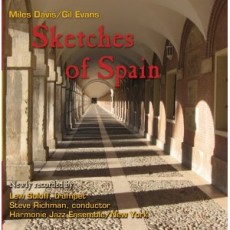
Daily Dose Of Jazz…
Lew Soloff was born February 20, 1944 in New York City and is a jazz trumpeter, composer and actor. Studying trumpet at the Eastman School of Music, he continued his studies at Julliard. After graduation he freelanced around New York City with Maynard Ferguson, Joe Henderson, Machito, Tito Puente and Clark Terry. From 1968 to 1973 he worked with Blood, Sweat and Tears.
By 1973 he began an association an association with Gil Evans, played with George Gruntz’s Concert Jazz Band, Carla Bley, and is a longtime member of the Manhattan Jazz Quintet. He has also teamed up with the colorful trombonist Ray Anderson on several often-humorous recordings.
In the 1980’s he was part of a jazz ensemble called Members Only, recording for Muse Records. A brilliant high note trumpeter, Lew has long been sought after to play in big bands and session work. He is a distinctive soloist and an expert with the plunger mute. He has over four-dozen albums to his credit as a leader and sideman and currently performs, tours and records.
More Posts: trumpet


